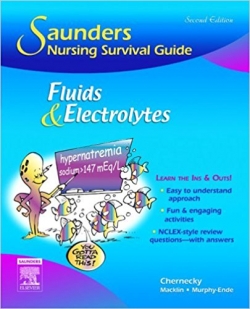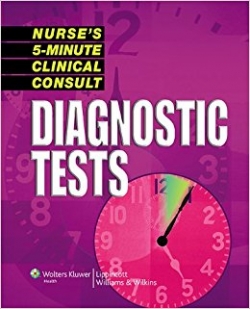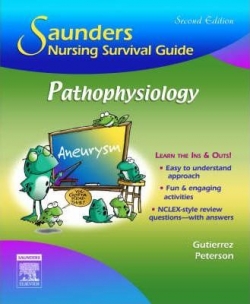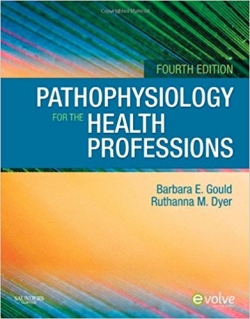Saunders nursing guide to laboratory and diagnostic tests
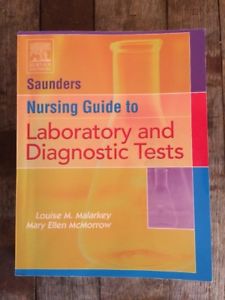
Buy online ($)
Type
Book
Authors
ISBN 10
141602057
Category
QY Clinical Laboratory Pathology
[ Browse Items ]
Publication Year
2005
Publisher
Saunders Elsevier, United States
Description
Saunders Nursing Guide to Laboratory and Diagnostic Tests, 2nd Edition is the perfect guide to laboratory testing for both students and practicing nurses alike. Featuring the latest testing information organized alphabetically for quick reference, this resource offers test formats that emphasize the nurse's specific role in all aspects of the testing process. Basics the Nurse Needs to Know and Nursing Care sections for every laboratory test explain what the nurse is to do during the pre-, post- and actual test stages, and highlights the nursing responses to critical values, complications, patient teaching, and health promotion. A new companion Evolve website also offers a variety of learning resources and skills videos to help you master diagnostic procedures and perform accurate testing. Alphabetical organization of the laboratory tests (featuring alphabetical thumb tabs) makes every test easy to find. Also Called sections feature synonyms and abbreviations that help you identify specific tests. Purpose of the Test states the indications of each test. Basics the Nurse Needs to Know offers an explanation of each test in clear, simple language. Normal Values in standard and SI units include variations for gender and age, where relevant. How the Test is Done succinctly describes how each test is performed. Significance of Test Results list the diseases and disorders that are associated with abnormal findings. Interfering Factors list the factors, such as drugs, herbs, and improper specimen collection and handling, that inadvertently affect test results. Nursing Care is divided into Pretest, During the Test, and Posttest, listing in detail what the nurse does in the testing process. Nursing Response to Critical Values and Nursing Response to Complications detail what you should be alert for before, during, and after the test and how to manage dangerous situations. Explicit incorporation of nursing concerns related to lab tests can only be found in this lab book. Over 50 new and updated pieces of art highlight how results are interpreted, what equipment is used, and how various techniques are performed. Over 20 new tests prepare you for the types of tests you will encounter during your clinical experience. Patient Teaching icons make crucial nursing content easy to find. New Student Resources on Evolve feature a variety of supplemental learning tools. Skills materials, including skills checklists, PDFs of skills, and brief skills video clips, help you master specimen collection and basic diagnostic procedures. Patient handouts provide practical, useable materials to make your clinical experience easier. Audio pronunciations simplify the process of learning difficult terminology.
This complete lab book contains the latest information on testing organized alphabetically for quick reference. It has student-friendly features that provide great information for practicing nurses. "Significance of Test Results" sections list the diseases and disorders that are associated with abnormal findings, and Test Result Indications sections list the possible clinical significance of abnormal findings. Tests are presented in a format that emphasizes the nurse's role, and includes Basics the Nurse Needs to Know and Nursing Care. The clinical purpose of each test is identified, and how each test is performed is clearly explained. A pronunciation guide for the name of each test helps with difficult terminology A focus on nursing explains how lab tests are used in nursing care. Alphabetical organization makes every test easy to find. Pronunciation guides for test names help students with difficult terminology. "Purpose of the Test" sections identify the indications of each test. "Basics the Nurse Needs to Know" offers an explanation of each test in clear, simple language. Normal Values in standard and SI units include variations for gender and age, where relevant. Critical Values are highlighted with the Normal Values, where relevant. "How the Test is Done" sections succinctly describe how each test is performed. "Significance of Test Results" sections list the diseases and disorders that are associated with abnormal findings. "Interfering Factors" sections list of the factors-such as drugs, herbs, and improper specimen collection and handling-that inadvertently affect test results. "Nursing Care" sections explain what the nurse is to do pretest, during the test, and posttest, and highlights nursing responses to critical values and complications, patient teaching, and health promotion. "Health Promotion" information is highlighted where relevant, noting the use of a test for screening asymptomatic individuals, with a testing schedule or other indication for when the test should be performed. Patient Teaching information is highlighted to make this crucial nursing content easy to find. Nursing Responses to Critical Values and Complications note what the nurse should be alert for during and after the test and how to manage dangerous situations. Appendix D: Common Laboratory and Diagnostic Tests for Frequently Occurring Medical Diagnoses lists the tests used most often for various disorders, and is a handy guide for students using lab tests in clinicals, as well as for practicing nurses. Appendix E: Tests by Body System with Test Purpose lists all tests with page number of the main entry, along with the purpose of each test for quick reference. The new JCAHO guidelines for abbreviations are followed to reduce errors in laboratory readings.
This complete lab book contains the latest information on testing organized alphabetically for quick reference. It has student-friendly features that provide great information for practicing nurses. "Significance of Test Results" sections list the diseases and disorders that are associated with abnormal findings, and Test Result Indications sections list the possible clinical significance of abnormal findings. Tests are presented in a format that emphasizes the nurse's role, and includes Basics the Nurse Needs to Know and Nursing Care. The clinical purpose of each test is identified, and how each test is performed is clearly explained. A pronunciation guide for the name of each test helps with difficult terminology A focus on nursing explains how lab tests are used in nursing care. Alphabetical organization makes every test easy to find. Pronunciation guides for test names help students with difficult terminology. "Purpose of the Test" sections identify the indications of each test. "Basics the Nurse Needs to Know" offers an explanation of each test in clear, simple language. Normal Values in standard and SI units include variations for gender and age, where relevant. Critical Values are highlighted with the Normal Values, where relevant. "How the Test is Done" sections succinctly describe how each test is performed. "Significance of Test Results" sections list the diseases and disorders that are associated with abnormal findings. "Interfering Factors" sections list of the factors-such as drugs, herbs, and improper specimen collection and handling-that inadvertently affect test results. "Nursing Care" sections explain what the nurse is to do pretest, during the test, and posttest, and highlights nursing responses to critical values and complications, patient teaching, and health promotion. "Health Promotion" information is highlighted where relevant, noting the use of a test for screening asymptomatic individuals, with a testing schedule or other indication for when the test should be performed. Patient Teaching information is highlighted to make this crucial nursing content easy to find. Nursing Responses to Critical Values and Complications note what the nurse should be alert for during and after the test and how to manage dangerous situations. Appendix D: Common Laboratory and Diagnostic Tests for Frequently Occurring Medical Diagnoses lists the tests used most often for various disorders, and is a handy guide for students using lab tests in clinicals, as well as for practicing nurses. Appendix E: Tests by Body System with Test Purpose lists all tests with page number of the main entry, along with the purpose of each test for quick reference. The new JCAHO guidelines for abbreviations are followed to reduce errors in laboratory readings.
Number of Copies
1
| Library | Accession No | Call No | Copy No | Edition | Location | Availability |
|---|---|---|---|---|---|---|
| Main | 52 | QY39.M237 2005 | 3 | Yes |
